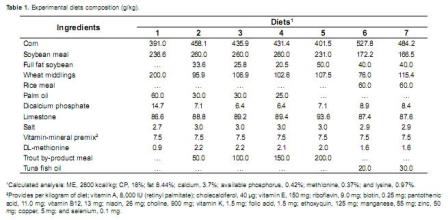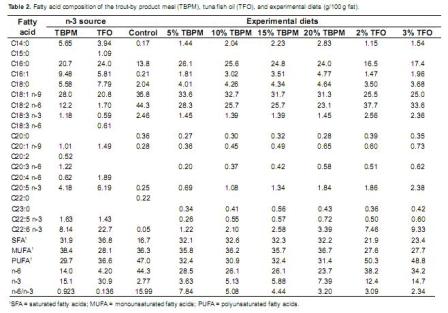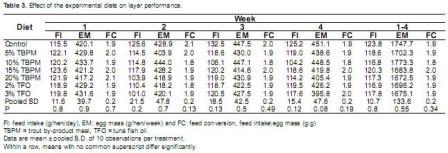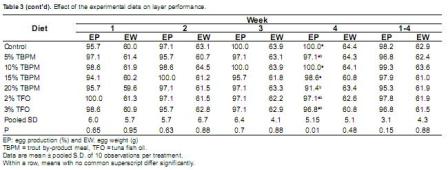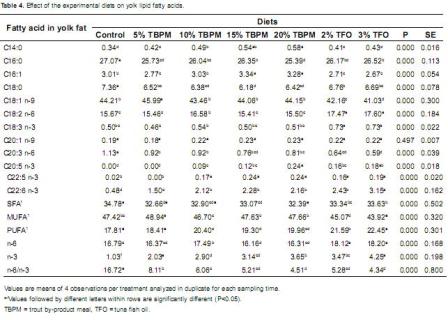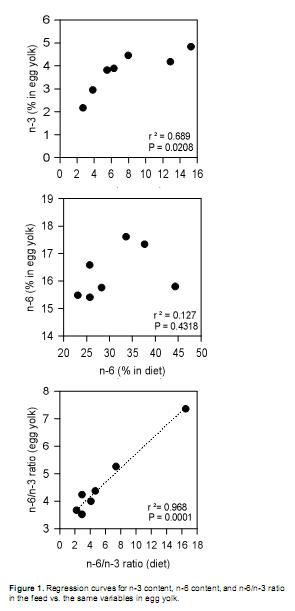Serviços Personalizados
Journal
Artigo
Indicadores
-
 Citado por SciELO
Citado por SciELO -
 Acessos
Acessos
Links relacionados
-
 Citado por Google
Citado por Google -
 Similares em
SciELO
Similares em
SciELO -
 Similares em Google
Similares em Google
Compartilhar
Revista Colombiana de Ciencias Pecuarias
versão impressa ISSN 0120-0690versão On-line ISSN 2256-2958
Rev Colom Cienc Pecua v.24 n.4 Medellín out./dez. 2011
Effect of feeding hens trout by-product meal or tuna fish oil on production parameters and yolk fatty acid profile¤
Efecto de la alimentación de gallinas con ensilaje de vísceras de trucha o aceite de atún en parámetros productivos y perfil de ácidos grasos en yema de huevo
Efeito da alimentação de galinhas com silagem de vísceras de truta ou óleo de atum nos parâmetros produtivos e o perfil de ácidos graxos na gema de ovo
Gonzalo J Díaz1*, MV, PhD; Amparo Cortés1, MV; Sandra M Cepeda1
1Laboratorio de Toxicología y Nutrición Aviar, Facultad de Medicina Veterinaria y de Zootecnia, Universidad Nacional de Colombia, Bogotá, D.C., Colombia.
(Recibido: 18 noviembre, 2010; aceptado: 23 agosto, 2011)
Objective: a study was conducted to evaluate two sources of omega-3 (n-3) fatty acid enrichment, namely a trout by-product meal (TBPM) and tuna fish oil (TFO), as potential sources for egg yolk n-3 enrichment. Methods: Seventy-27 week old commercial layers were assigned to each of seven dietary treatments, as follows. Group 1: control; group 2: 5% TBPM; group 3: 10% TBPM; group 4: 15% TBPM; group 5: 20% TBPM; group 6: 2% TFO; and group 7: 3% TFO. The experimental diets were fed for 28 days. Results: no effect on production parameters was caused by the experimental diets. All diets containing TBPM or TFO significantly (p<0.05) increased n-3 egg yolk fatty acid content. Dietary levels of 5-20% TBPM increased egg yolk n-3 content between 1.97 and 3.54 times compared with control eggs. TFO levels of 2% and 3% increased the n-3 egg yolk content 3.37 and 4.13 times, respectively, compared with control eggs. The n-6/n-3 ratio in egg yolk lipids was significantly (p<0.05) decreased by the experimental diets. The n-6/n-3 ratio in control eggs was 16.79 compared with ratios ranging from 4.34 to 8.11 in enriched eggs. Conclusions: the results showed that both TBPM and TFO are good sources of n-3 fatty acid enrichment in eggs. Further studies are required in order to determine the effects of TBPM and TFO inclusion on the organoleptic quality of eggs.
Key words: hens, n-3 fatty acids, omega-3 eggs, trout by-product meal , tuna fish oil.
Resumen
Objetivo: se realizó un estudio para evaluar dos potenciales fuentes de enriquecimiento de ácidos grasos omega-3 (n-3) en yema de huevo: ensilaje de vísceras de trucha (TBPM) y aceite de atún (TFO). Métodos: un total de 70 gallinas de postura de 27 semanas se asignaron a siete tratamientos dietarios, así: grupo 1: control; grupo 2: 5% TBPM; grupo 3: 10% TBPM; grupo 4: 15% TBPM; grupo 5: 20% TBPM; grupo 6: 2% TFO y grupo 7: 3% TFO. Las dietas experimentales se suministraron durante 28 días. Resultados: no se encontraron efectos sobre los parámetros productivos a causa de las dietas experimentales, pero todas las dietas suplementadas con TBPM o TFO causaron un aumento significativo (p<0.05) en el contenido de n-3 de la yema. La suplementación de 5-20% de TBPM causó un incremento de n-3 de 1.97 a 3.54 veces, comparado con el contenido de n-3 de los huevos control. La suplementación de 2% y 3% de TFO incrementó en contenido de n-3 en 3.37 y 4.13 veces, respectivamente. La relación n-6/n-3 en los lípidos de la yema aumentó significativamente en las dietas experimentales siendo esta relación de 16.79 en los huevos control y de 4.34-8.11 en los huevos de gallinas suplementadas con las fuentes de n-3. Conclusiones: los resultados del presente estudio demuestran que tanto el TBPM como el TFO constituyen fuentes apropiadas de enriquecimiento de huevos con ácidos grasos n-3. Se requieren más estudios para determinar los efectos de estas materias primas en la calidad organoléptica del huevo.
Palabras clave: aceite de atún, ácidos grasos n-3, ensilaje de vísceras de trucha, gallinas de postura.
Resumo
Objetivo: Foi realizado um estudo para avaliar duas fontes potenciais de enriquecimento de ômega-3 (n-3) na gema de ovo: silagem de vísceras de truta (TBPM) e óleo de atum (TFO). Métodos: Um total de 70 galinhas poedeiras de 27 semanas, foram atribuídas a sete tratamentos dietéticos: grupo 1: controle, grupo 2: 5%TBPM, grupo 3: 10% TBPM, grupo 4: 15% TBPM, grupo 5: 20% TBPM, grupo 6: 2% TFO e grupo 7: TFO 3%. As dietas experimentais foram subministradas durante 28 dias. Resultados: Não foram encontradas diferencias nos parâmetros de produção por causa das dietas experimentais, mas todas as dietas suplementadas com TFO ou TBPM causaram um aumento significativo (p<0.05) no conteúdo de n-3 da gema. A suplementação de 5-20% de TBPM causou um aumento de n-3 de 1.97 a 3.54 vezes, em comparação com o conteúdo de n-3 do controle. A suplementação de 2% e 3% de TFO aumentou o conteúdo de n-3 em 3.37 e 4.13 vezes, respectivamente. A relação n-6/n-3 nos lipídios da gema aumentou significativamente nas dietas experimentais, sendo esta relação de 16.79 nos ovos do controle e de 4.43 a 8.11 em ovos de galinha suplementados com fontes de n-3. Conclusões: Os resultados deste estudo demonstram que o TFO e o TBPM são fontes apropriadas de enriquecimento de ovos com n-3 ácidos graxos. Mais estudos são necessários para determinar os efeitos dessas matérias primas na qualidade organoléptica do ovo.
Palavras chave: ácidos graxos, avicultura, óleo de atum.
¤ To cite this article: Díaz GJ, Cortés A, Cepeda SM. Effect of feeding hens trout by-product meal or tuna fish oil on production parameters and yolk fatty acid profile. Rev Colomb Cienc Pecu 2011; 24:609-616
* Corresponding author: Gonzalo J Díaz. Laboratorio de Toxicología, Facultad de Medicina Veterinaria y de Zootecnia, Universidad Nacional de Colombia. E-mail: gjdiazg@unal.edu.co
Introduction
The omega-3 (n-3) are a group of fatty acids with important implications for human health. Recommendations about the intake of dietary fat point out the importance of consuming higher levels of n-3 fatty acids (Leskanich and Noble, 1997; Kris-Etherton et al., 2003). Current Western diets are not only deficient in n-3 fatty acids, but also have excessive amounts of omega-6 (n-6) fatty acids compared with the diet on which the human race evolved (Simopoulus, 2002). The large amounts of dietary n-6 fatty acids and the high n-6/n-3 ratio commonly found in Western diets (10:1 to 25:1) promote the pathogenesis ofcardiovascular, inflammatory and autoimmune diseases, while increased levels of n-3 fatty acids (and a lower n-6/n-3 ratio) has protective effects (Simopoulus, 2002). One way of increasing the intake of n-3 fatty acids is through the intake of natural sources rich in these fatty acids such as oily fish, and flax seed. Another possibility is through the consumption of functional foods enriched in n-3 fatty acids such as enriched eggs (Lewis et al., 2000).
Several studies have shown that it is possible to increase the amount of n-3 fatty acids (and decrease the n-6/n-3 ratio) in the egg yolk by feeding hens diets enriched with sources of n-3 fatty acids such as menhaden oil, tuna fishmeal, linseed oil, and others (Leskanich and Noble, 1997; Baucells et al., 2000; Gonzalez-Esquerra and Leeson, 2000; Lewis et al., 2000; Howe et al., 2002). These sources of n-3 fatty acids, however, are not readily available in such countries as Colombia. The aim the present study was to evaluate two sources of n-3 fatty acids available in the Colombian market, namely trout by-product meal (TBPM) and tuna fish oil (TFO), as potential sources for the enrichment of eggs with n-3 fatty acids.
Materials and methods
27-week old commercial layers of the Hy-Line Brown strain were assigned to each of seven dietary treatments that consisted of diets containing increasing levels of a source of n-3 fatty acids, as follows. Group 1: control; group 2: 5% TBPM; group 3: 10% TBPM; group 4: 15% TBPM; group 5: 20% TBPM; group 6: 2% TFO; and group 7: 3% TFO. Since there are several studies reporting the use of FO as a source of enrichment with n-3 fatty acids (Baucells et al., 2000) it was decided to use this ingredient in only two groups and to test four levels of TBPM, a novel source of n-3 fatty acids.
For the preparation of the TBPM a total of 200 kg of trout inner guts was mixed with 15% molasses, 0.2% Lactobacillus bulgaricus, 0.1% potassium sorbate (as antifungal agent) and 50 ml/kg of crushed onion as antioxidant, as described before (Betancourt et al., 2005). The mix was kept in tightly closed 50 kg plastic drums and mixed three times daily in order to homogenize the fermentation process. The fermentation lasted for 30 days until a complete liquefaction of the product was obtained. The experimental diets were formulated to contain or exceed the concentrations of required nutrients for laying hens and were isocaloric and isoproteic (Leeson and Summers, 2001). The ingredient composition and calculated analysis of the experimental diets is summarized in table 1. Fatty acid compositions of TBPM, TFO, and each experimental diet are presented in table 2. Proximate analysis of the TBPM revealed the following composition (g/kg): Dry matter, 384.0; ether extract, 353.0; crude protein, 204.0; ash, 66.0; crude fiber, 10.0; non-nitrogen extract (calculated), 186.0.
The birds were allocated at random to one of the seven dietary treatments, with 10 individual birds per treatment. Hens were kept in individual wire cages with artificial light provided 14 h per day. Feed and water were provided ad libitum during 28 days.
Body weight was recorded at the beginning (27 weeks of age) and at weekly intervals until the end of the experiment (31 weeks of age). Egg production and egg weight was recorded daily and individually. Individual feed intake was measured at weekly intervals. At days 7, 14, 21 and 28 of the experiment, eight yolks from each dietary treatment were pooled into two 4-yolk replicates and analyzed to determine the fatty acid composition.
The samples were processed according to the methods described by Folch et al. (1957) for extraction of lipids and by Betancourt et al. (2005) for the determination of the fatty acid profile. In summary, to one gram of yolk 40 ml of chloroform:methanol 2:1 were added, and the mix was homogenized and filtered to obtain 20 ml of extract to which 5 ml of water were added. The mix was homogenized again and centrifuged at 3.000 rpm for 10 minutes. The supernatant was removed and eliminated and 1 ml of the lower layer was transferred to a previously weighed test tube. The solvent was then evaporated under a gently stream of nitrogen and the dry film remaining was redissolved with methyl chloride to a concentration of 25 mg/ml. From this solution 20 µl were taken and added with 160 µl methylene chloride and 20 µl of Meth-Prep II transesterification reagent (Alltech Associates, Inc., Deefield, IL, USA). The mix was left at ambient temperature for 30 minutes and then 1 µl of the solution was injected into the gas chromatograph for the determination of the fatty acid methyl esthers (FAMEs).
The FAMEs were separated using a 30 m x 0.32 mm inside diameter x 0.25 µm film thickness OmegawaxTM 320 fused silica capillary GC column (Supelco, Inc., Bellefonte, PA, USA) and analyzed with a Shimadzu GC-14A Gas Chromatograph (Shimadzu Scientific Instruments, Columbia, MD, USA) equipped with a flame ionization detector. The separation was obtained with a temperature ramp (initial temperature 80°C, 10 °C/min to 190 °C, 20 min at 190 °C, 2 °C/min to 220 °C and 10 min at 220 °C) using helium as carrier gas. The injection was made in split mode with a split ratio of 1:50. Retention times were compared with known standards (Supelco, Inc., Bellefonte, PA, USA).
Statistical Analysis
Data (treatment means) were subjected to one- way ANOVA by using the General Linear Model procedure of SAS (SAS® Institute, 2008). When the F-test for treatments was significant at p<0.05 in the ANOVA analysis, means were compared for significant differences using Duncan's multiple range test. Regression analysis was also conducted to determine the relationship between dietary and egg yolk n-3, n-6 and n-6/n-3 fatty acids in order to obtain both the correlation coefficient and P value of the regression model.
Results
Table 3 summarizes the effect of the experimental diets on layer performance. In general, no effects on layer performance were caused by the experimental diets, although layers fed 20% TBPM had a significantly lower (p<0.05) percent production during week 4 of the experiment compared with controls. However, the overall 28-day percent production of the hens fed 20% TBPM was not significantly different from that of the control group. No other significant differences in layer performance were observed during the experiment. No significant differences in body weight were recorded at any of the scheduled sampling times (data not shown).
No significant differences in the fatty acid profile were observed at days 7, 14, 21 or 28 of the experiment (data not shown), and therefore it was decided to pool the data corresponding to the four sampling times (Table 4). All diets containing TBPM or TFO caused a significant increase in n-3 egg yolk fatty acid content. Levels of n-3 fatty acids were especially high in the groups fed 20% TBPM and 3% TFO (3.65%, and 4.25%, respectively) which corresponded to 3.5 and 4.1 times the levels of the control group (1.03%). The n-6/n-3 ratio was significantly lower in all egg yolks from hens receiving the dietary sources of n-3 fatty acids. The reduction in the n-6/n-3 ratio was significant (p<0.05) in all dietary treatments and corresponded to a n-6/n-3 ratio close to 17 in control eggs, compared with ratios ranging from 4.34 to 8.11 in n-3 enriched eggs.
Figure 1 shows the regression analysis of the n-3, and n-6 fatty acid content, and the n-6/n-3 ratio in the diet vs. their corresponding values in egg yolk. A linear relationship was observed for the n-3 content (r2 = 0.689, P = 0.0208), and for the n-6/n-3 ratio (r2 = 0.968, P = 0.0001). However, the n-6 dietary content was not linearly related to the n-6 egg yolk content (r2 = 0.127, P = 0.4318).
Discussion
The effect of FO supplementation on performance parameters is in agreement with that observed in previous studies in which similar levels of fish oil (up to 4%) were included in the diet of layers (Hargis et al., 1991; Van Elswyk et al., 1992; Baucells et al., 2000; Gonzalez-Esquerra and Leeson, 2000). Our results corroborate previous observations in which no effect on layer performance are observed when diets enriched with n-3 fatty acids are given to the birds. Unfortunately, no previous reports on the use of TBPM as an ingredient for laying hen diets or as a source of n-3 fatty acids were found in the literature and therefore it is not possible to contrast our results with previous ones.
The levels of n-3 enrichment observed with the dietary supplementation of FO (and TBPM) are similar to those reported in previous studies. For example, layers fed 4% deodorized menhaden oil had omega-3 fatty acid content in egg yolk of 4.13% compared with 1.04% in the control group (Gonzalez-Ezquerra and Leeson, 2000). In another study (Baucells et al., 2000) layers fed a diet containing 4% FO laid eggs containing 5.06% omega-3 fatty acids compared with an omega-3 fatty acid content of 0.87% found in the eggs of hens fed a diet containing tallow instead of FO.
The decrease in the n-6/n-3 ratio observed in the present study in the eggs of birds supplemented with n-3 sources is consistent with the decrease reported in previous studies. For instance, Simopoulus (2000) reported an n-6/n-3 ratio of 19.9 in supermarket eggs versus a ratio of 6.6 in "fishmeal eggs". Similarly, Baucells et al. (2000) reported that the n-6/n-3 ratio in egg yolk decreased from 15.58 in hens fed a diet containing tallow to 2.42 in hens fed a diet containing 4% FO. Interestingly, significantly higher levels of n-6 fatty acids were obtained in eggs from hens receiving 10% TBPM and 2% and 3% TFO; however, these levels were only between 6.2 and 8.4% greater than those of the control group, and therefore did not affect the n-6/n-3 ratio significantly.
In general, it is accepted that the amount of long chain polyunsaturates within the yolk is a reflection of the amount within the diet (Leskanich and Noble, 1997). In the present study, this fact was true for n-3 fatty acids, but not for n-6 fatty acids (Figure 1). We cannot provide an explanation for this observation but it might be possible that the reason lies on the essentiality of linoleic acid (18:2n6), the main n-6 fatty acid. The only essential fatty acid for chickens is linoleic acid (Watkins, 1995) and it is possible that this acid is being used as a precursor of other compounds (for instance prostaglandins 1 and 2) instead of being transported entirely into the egg yolk. This fact would explain why the n-6 fatty acid content in the diet is not linearly related to the n-3 fatty acid content in egg yolk.
The fact that a linear relationship exist for the n-6/n-3 ratio in feed and yolk indicates that the n-6/n-3 ratio of the diet could be used as a good predictor of the n-6/n-3 ratio in yolk. However, dietary n-3 content is not as accurate as a predictor of the n-3 yolk content, and the dietary n-6 content is not linearly related to the egg yolk n-6 content as it was previously discussed.
The results of the present study indicate that TBPM, a product potentially available in the Colombian market, with an n-3 fatty acid content of 15.13% and an n-6/n-3 ratio of 0.923, is an adequate source for the enrichment of eggs with n-3 fatty acids. Supplementing diets with levels of 5-20% TBPM, results in the production of egg yolks containing between 1.97 and 3.54 times more n-3 fatty acids than those from non-supplemented diets.
The level of n-3 enrichment was also high with TFO, resulting in eggs containing between 3.37 to 4.13 times higher levels of n-3 fatty acids than those of control eggs. TFO contains more n-3 fatty acids (30.86%) and has a lower n-6/n-3 ratio (0.136) compared with TBPM. Further studies are required, however, in order to determine the effects of these ingredients on the organoleptic quality of the eggs.
It has been recommended to increase the dietary intake of n-3 fatty acids in humans (Simopoulus, 2002; Kris-Etherton et al., 2003) and both sources of n-3 fatty acids tested in the present trial can be used to produce eggs containing a higher content of n-3 fatty acids. Although supplements are a suitable alternative for n-3 fatty acid intake it has been recommended that a food-based approach is preferable (Kris-Etherton et al., 2003). An increased intake of n-3 fatty acids, along with a decreased intake of oils rich in n-6 fatty acids (e.g. corn, soybean, and sunflower oil) will help consumers obtain a dietary n-6/n-3 ratio which approaches the 1:1 to 4:1 ratio recommended for a human diet (Simopoulus, 2000).
References
1. Baucells MD, Crespo N, Barroeta AC, Lopez-Ferrer S, Grashorn MA. Incorporation of different polyunsaturated fatty acids into eggs. Poult Sci 2000; 79:51-59. [ Links ]
2. Betancourt L, Diaz GJ, Aguilar X, Ríos J. Efecto del ensilaje de vísceras de trucha (Oncorhynchus mykiss) sobre el comportamiento productive y el contenido de ácidos omega-3 en hígado, muslos y pechuga, de pollos de engorde. Livest Res Rural Develop 2005; [17: Article #106, fecha de acceso: Abril 26 de 2011] URL: http://www.lrrd.org/lrrd17/9/beta17106.htm [ Links ]
3. Folch J, Lees M, Stanley GSH. A simple method for the isolation and purification of total lipides from animal tissues. J Biol Chem 1957; 226:497-509. [ Links ]
4. Gonzalez-Esquerra R, Leeson S. Effect of feeding hens regular and deodorized Menhaden oil on production parameters, yolk fatty acid profile, and sensory quality of eggs. Poult Sci 2000; 79:1597-1602. [ Links ]
5. Hargis PS, Van Elswyk ME, Hargis BM. Dietary modification of yolk lipids with menhaden oil. Poult Sci 1991; 70:874-883. [ Links ]
6. Howe PR, Downing JA, Grenyer BF, Grigonis-Deane EM, Bryden WL. Tuna fishmeal as a source of DHA for n-3 PUFA enrichment of pork, chicken, and eggs. Lipids 2002; 37:1067-1076. [ Links ]
7. Kris-Etherton PM, Harris S, Appel LJ. Omega-3 fatty acids and cardiovascular disease: New recommendations from the American Heart Association. Arterioscler Thromb Vasc Biol 2003; 23:151-152. [ Links ]
8. Leskanich CO, Noble RC. Manipulation of the n-3 polyunsaturated fatty acid composition of avian eggs and meat. Worlds Poult Sci J 1997; 53:155-183. [ Links ]
9. Leeson S, Summers JD. Scott's Nutrition of the Chicken. 4th ed. Guelph (ON): University Books; 2001. [ Links ]
10. Lewis NM, Seburg S, Flanagan NL. Enriched eggs as a source of n-3 polyunsaturated fatty acids for humans. Poult Sci 2000; 79:971-974. [ Links ]
11. SAS Institute Inc. SAS/STAT 9.2 User's Guide. Cary (NC): SAS Institute Inc.; 2008. [ Links ]
12. Simopoulus AP. Human requirement for n-3 polyunsaturated fatty acids. Poult Sci 2000; 79:961-970. [ Links ]
13. Simopoulus AP. The importance of the ratio of omega-6/ omega-3 essential fatty acids. Biomed Pharmacother 2002; 56:365-379. [ Links ]
14. Van Elswyk ME, Sams AR, Hargis PS. Composition, Functionality, and sensory evaluation of eggs from hens fed dietary menhaden oil. J Food Sci 1992; 57:342-344, 349. [ Links ]
15. Watkins BA. Biochemical and physiological aspects of polyunsaturates. Poult Av Biol Rev 1995; 6:1-18. [ Links ]













